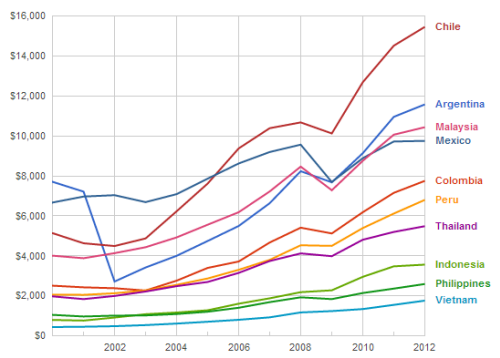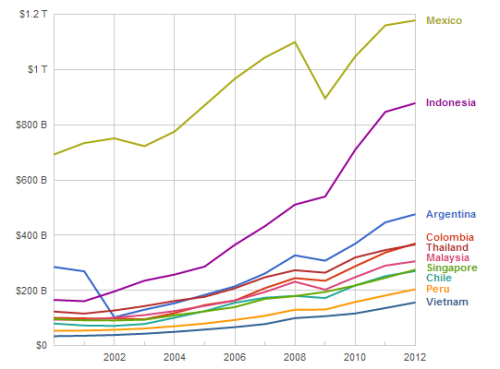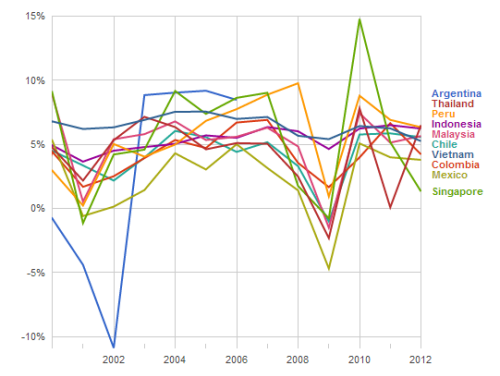Latin America’s growth and development is as exciting as East Asia’s
I am in South America this week, giving keynotes at the sCRM-CEM y Redes Sociales conference in Bogota and the Congreso Internacional de Retail in Lima.
Latin America is a fascinating and exciting region, both culturally and economically. However the region, while highly visible in North America, does not tend to get much attention from the rest of the world.
The dramatic economic rise of China is a dominant theme of this century, with India likely to gain ground on China in coming decades due to demographic shifts. This is drawing pointed attention from business executives around the world to Asia as a growth region. However to a certain degree the rise of China and India, and that of the rest of Asia, are distinct stories.
This first chart shows GDP of the major developing countries in Asia and Latin America (excluding Japan, Taiwan, and South Korea as established economies that are growing more slowly or not at all). China completely dominates in the extent and consistency of its growth. Considerably behind is Brazil, the second of the BRICs, followed by India.
GDP – large developing countries in Asia and Latin America – all

Source: World Bank
If we take out the world’s three largest developing economies we can get more context on the next layer of growth. Mexico is a large economy, though not growing as fast as some others, while Indonesia is growing consistently, with massive potential given its population of almost 250 million. Argentina has had highly inconsistent growth but has the potential to revert to earlier strong development. Colombia and Thailand are of similar sizes. Among the next tier Peru is outpacing Vietnam in both size of the economy and growth rate.
GDP – mid-sized developing countries in Asia and Latin America
Comparing GDP growth since 2000 shows that Latin American and Asian countries have similar growth rates. Peru has had one of the most consistent growth rates in recent years, averaging 7% per annum even taking into account the global financial crisis.
GDP growth – mid-sized developing countries in Asia and Latin America
This final chart shows GDP per capita across these countries. Latin American countries tend to be significantly more economically developed than Asia’s developing countries, even while they are maintaining and look set to continue strong growth.
The massive population of China and South Asia including India hides the fact that there are ‘just’ around 550 million people in developing East Asia, compared to 600 million in Latin America.
GDP per capita – mid-sized developing countries in Asia and Latin America

Source: World Bank
Another important point is that just two highly similar languages – Spanish and Portugese – are spoken across Latin America and there is a strong cultural alignment across the region.
In contrast, developing Asia is extraordinarily diverse in both language and culture. Each country – and indeed in many cases different sectors of the population – must be addressed as distinct markets.
This simple comparison of developing Asia and Latin America shows that while what is happening in Asia is extraordinarily exciting, the opportunities in Latin America come close to matching them.
I look forward to spending more time in the very exciting Latin American region. It’s time for me to refresh my Spanish, which has been getting rather rusty of late but hopefully shouldn’t take too much work to get back into shape.


